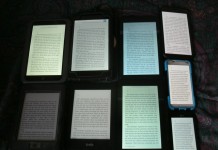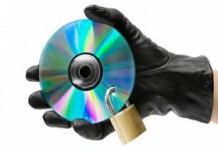 I felt guilty. Here I was making the best-seller lists for e-books, yet I kept reading just print books.
I felt guilty. Here I was making the best-seller lists for e-books, yet I kept reading just print books.
Most of my e-books were also in print. But was I still a traitor to my fans who read me in E instead? I remembered when my wife Betty and I had closed our Choose and Cut Christmas tree farm, then promptly bought a fake tree.
So why did I continue to be an e-traitor? First was the complexity of buying and downloading books in what seemed to be dozens of different formats. Next was battery life. When I’m not writing or talking with Betty, I’m reading; and I didn’t want to worry about recharging the device constantly. Then there was the eyestrain of long hours staring at computer screens; did I need more of it? And last was, frankly, resistance to change. I’d been reading print books so long, in bed, in my easy chair, at the dinner table, in doctor’s offices, that e-books didn’t seem like the real thing.
In search of the perfect reader/guilt-stopper
 Guilt, however, finally won, and I started shopping for the right device. Some people told me I’d be perfectly happy reading books on a Palm or something similar, but I doubted it; the screen wasn’t even as big as a typical paperback’s. Nor was reading on my desktop PC an option, because I already spend most of the day sitting in front of my desktop monitor. When I read I want to go to my easy chair or to bed and relax, so I can really get into the book, and I can’t do it sitting at my computer. I kept hearing about the amazing new technology called E Ink that was supposed to give readers long, long battery life, but it seemed it would never hit the market. Finally I decided to jump and Betty bought me an eBookwise e-reader for my birthday.
Guilt, however, finally won, and I started shopping for the right device. Some people told me I’d be perfectly happy reading books on a Palm or something similar, but I doubted it; the screen wasn’t even as big as a typical paperback’s. Nor was reading on my desktop PC an option, because I already spend most of the day sitting in front of my desktop monitor. When I read I want to go to my easy chair or to bed and relax, so I can really get into the book, and I can’t do it sitting at my computer. I kept hearing about the amazing new technology called E Ink that was supposed to give readers long, long battery life, but it seemed it would never hit the market. Finally I decided to jump and Betty bought me an eBookwise e-reader for my birthday.
While I don’t know much about computers, I was still aggravated over the two full days I needed to master the pesky thing and download my first book.
I never did get fully comfortable with the eBookwise. The one time I really used and enjoyed it was on a five-day cruise where I could read in bed without disturbing Betty because it had a backlight. But after that, I relied on the eBookwise less and less and gradually went back to reading regular print books. In all fairness, I should note that the eBookwise had and has its fans. Many of my correspondents and members of on-line groups I belong to were very well pleased with the eBookwise, particularly the low price compared to other devices. And hardly anyone else reported having problems getting it set up and working. As I said, I’m not much of a techie, so I think that was my fault and not that of the e-reader.
What E needs
As technology-challenged I am, I still saw e-books as the future. I kept investigating the new readers and, finally, learned of the Sony Reader with E Ink. Battery power and screen glare would no longer be an issue. But gads, the price, $350! I decided to wait a while.
In the meantime, I kept reading about the various devices and began making a list of what I wanted to see in an e-book reader, the functions that would convert me to reading e-books once and for all—and the ones I think would induce fans to read my books on an e-reader!
Eventually I arrived at what I feel are the primary considerations if e-books are to become the venue for reading in the future, not just for me but for the majority of people who really like to read. And here they are, in no particular order:
Long battery life. The E Ink technology has pretty well taken care of this fault. With the Sony Reader, you can read thousands of pages before running out of power.
- Ability to change fonts. This is also available in most e-book readers and is especially important for older folks like me. No more reading glasses—just click the font up one notch larger! A print book sure can’t do that!
- An alphabetized and/or categorized storage place for my books that is easy to access. A desktop computer might work if need be. What I’d prefer is something like my present bookshelves that I wouldn’t have to convert as technology changed and that would be instantly available to my reader.
- A selection of books as great as a regular bookstore, or what a bookstore can order for you. Perhaps Amazon with the Kindle is moving in this direction but it isn’t anywhere near there yet.
- Ability to browse at an e-book store then download books wherever I am. Amazon again appears to have that problem in hand, or very near, at least.
- A reasonable price for the reader. Four hundred dollars seems a bit much for a book reader, but I believe the price will come down as E Ink technology replaces the present reading screens and mass production lowers the price.
- Ease of holding, page turning, book marking and reading, just as if I were holding a paperback novel in my hand. All those factors are well on the way, if not all here completely yet.
- Color display. This is important to me because some of my titles have exceptionally attractive, eye-grabbing covers (e.g., Savage Survival ). Yes, some folks might ask, “Why do you need a cover for an e-book?” The answer is the same as why print books have covers—to attract potential readers. Color is also important for children’s books. The readers using E Ink don’t have color yet but I’ve read the research and I believe it’s coming in the next few years.
- Easy on the eyes. After I’ve spent most of the day at my desktop computer writing, I want to relax my eyes with some regular print reading. E Ink technology certainly solved that problem. I’ve heard it’s even easier on the eyes than regular print books!
- And last—a few other bells and whistles, but make them optional. For instance it would be nice to be able to check e-mail, read audio books, take pictures, surf the net and use the reader as a telephone, but I repeat: these features should be optional and should not be added until and unless they blend seamlessly with the reader. And not buying the options should reduce the price proportionately. After all, a great many readers, like me,are interested in an e-book reader for one primary purpose—to read books! Are you listening, manufacturers? Keep it simple! A basic, no-frills E Ink reader shouldn’t cost more than a hundred or a hundred fifty dollars at most. If buyers want options, then let them pay for the extras.
Worth repeating
Okay, I know a lot of this has been said before, but I thought it bore repeating. I read a great deal, and so does my wife. When we buy a reader, we want to read and be at ease while reading, and, given our age, not strain our eyes while doing it.
Also, having said all this, I’m almost certainly going to ask Santa Claus to bring me a Kindle e-book reader next Christmas and I’m only waiting that long because I know the first version of just about any gadget has bugs in it. I’ll hold out for the next version, but I can’t wait on everything to be perfect. And you know what’s going to sell me? The ability to download a book wherever I am, combined with E Ink technology that gives long battery life and is easy on the eyes. Of course, the fact that all my books are available on the Kindle is sort of an inducement as well. I hope it is for you, too!
Moderator’s note: Bain fans should keep their eyes open for one of Darrell’s newest releases, Human By Choice, his joint project with Travis S. “Doc Travis” Taylor, known for Warp Speed and for Von Neuman’s War (written in collaboration with John Ringo). The e-book version should be out in a couple of months and the print version sometime in ’08. – David Rothman


































Good post, Darrell,
I went through my ‘feeling like a traitor’ stage, too. Like you, I actually got into the eBook business a long time before I bought a reader (although I did read eBooks on the computer). Since I spent my life on the computer, reading didn’t seem a big step. Except the portability issue comes into it.
I guess I don’t really see the need for color–unless I start reading children’s books. And I’ve had better luck with my eBookWise than you have. Still, you have to figure that if people like us–who’ve been reading paper books for fifty years or so–can come around, the rest of the world will, too.
Rob Preece
Publisher, http://www.BooksForABuck.com
I read both ebooks and print books. I’ve been reading ebooks for about two years on a Dell Axim PDA. For me, the fact that it will do other things (music, Internet) offsets the small size of the screen, since I travel about once a month. A larger screen with those same capabilities would be great, though.
I love ebooks but still buy print books when I know I’m going to want to lend them to someone. I also find I’m more likely to reread a print book than an ebook, probably because it’s easier to skim.
I have two other things for the wishlist:
* I don’t want to be locked into a format. Competition is good for the industry.
* The capability to mark a book as read or unread, just like I can do with my e-mail, and to assign the books to lists. I use MS Reader software now, which doesn’t have those capabilities. I have more than 500 books on the PDA, and it’s hard to keep track. (Other reader software, like Mobipocket, can do those things.)
Darrell, before jumping on the Kindle bandwagon next year, be sure to check out where other devices are. I got the new Sony 505 this year precisely because I want the ebook experience to simulate the print book experience and Sony came closest today to that desire for me.
I’m less concerned about being able to download a book from anywhere. If I’m going on a 3-week vacation, I can load my Sony with 50 books, say, and I doubt I’ll manage to get through them all. My point only being that because the readers can hold so many books at a time, I see no need to be constantly connected.
Downloading from anywhere isn’t one of the biggest issues for me, but it is one of them for the following reasons: it might be nice if I wanted to demonstrate the gadget or if someone told me about a book and I wanted to check it out on the spot, etc. Just a nice thought about being able to go to a library where ever you are, too. And if you like newspapers, and I do, downloading from anywhere could turn into a big issue on a trip!
Darrell
Welcome to the e-fold, Darrell!
Like you, the Kindle’s “instant gratification factor” (the ability to buy and download content whenever you’re within Sprint’s coverage area) was the primary feature that attracted my wife to the Kindle. But after getting her hands on my iRex iLiad (which I only just received yesterday), her interest in the Kindle waned considerably. When she realized how much content can be stored on a 2GB memory card, and when she saw that a simple drag-and-drop operation is all it takes to install content on the reader from her computer, the Kindle’s buy-it-now feature didn’t seem quite as important to her.
I fully agree with you about price. These gizmos won’t really take off in the marketplace until they reach the $100 price point. Prices will come down a bit as e-Ink displays find their way into more and more products, but I suspect we won’t be seeing very many of them in mass-market consumer devices until they can do a much better job with color content. But there’s still the chicken/egg problem of supply and demand, which is why it’s important that all of us who care about the future of e-publishing buy some device — any device — today to help create a market and drive production costs down.
As you shop for an e-reader, be sure to remember that whatever product you choose, you won’t be happy with it in two or three years. Technology will have marched on, the hardware and software will have matured (compare anything on the market today with a Rocket E-Book and you’ll see what I mean), and some sexy young thing will come along and try to seduce you away from your old sweetheart. 😉
What I want:
– It has to be small, preferably integrated into my organizer+phone so that I won’t have to carry several devices with me all the time. (Only one device also means only one charger to keep with me and only one thing to remember to keep charged.)
– A lit display, because I often read in the dark.
– An A5 sized display, so that it can display half of an A4 page at a time. (For all those pre-formatted (possibly scanned) scientific papers in ps or pdf.)
– A foldable display, since I don’t want to carry an A5-sized device in my pocket.
– FAST! I don’t think I could ever stand the e-ink devices’ 1000+ ms page flip times. (I’m almost annoyed by the 150 ms page flip time of my Nokia E61.)
– Qwerty-keyboard, preferably physical (as opposed to on-screen).
– Open for 3rd party applications.
– User-changeable battery.
– Decent operating time, the battery can’t go dead after 4 hours of reading.
– Preferably no DRM support. (I don’t want to give money to anyone that support such anti-humanity tactics.)
I won’t buy a device unless it has a backlight so I can read in the dark. I know e-ink is very nice, but no light, no buy for me. 🙂
No-back light means longer battery life. But just like your paper books you can add a clip on front light.
FYI: An E Ink electronic paper display is reflective technology, like paper or most object around you. LCDs use emissive technology, like looking into a flash light, which is why you should take a break on your computer every 45 minutes to let your eyes rest.
Just out of curiosity, I was wondering if anyone has had any experience with elementary level students reading e-books? What equipment would you recommend?
Cindy
Cindy, check out a EdTech Associates, which has K-12-related links. Also see The Paperless Classroom. It’s an old site and for Middle School, not elementary school, but one of the best I’ve seen, with lots of how-tos even if the equipment is old. Also don’t forget the OLPC news forums. Let us know how you fare. I think the OLPC machines, if you can get them, would be an interesting alternative to PDAs. For some reading material, don’t forget the International Childrens Digital Library. These suggestions are just starters. Remember—the content is even more important than the equipment. Oh, and also see Richard Ballaver’s work. Best of luck! – David